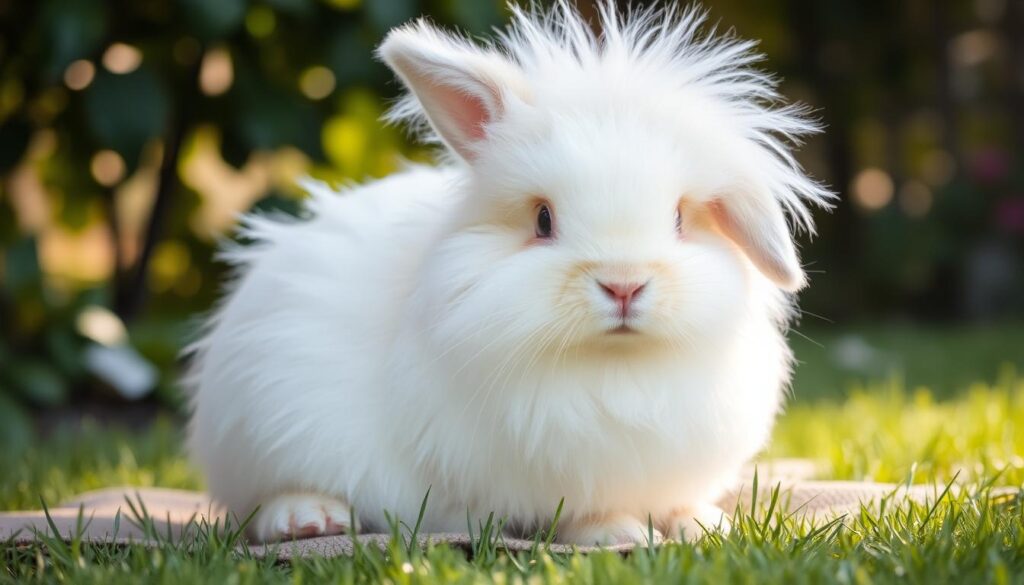Table of Contents
- Introduction to the Majestic Angora Rabbit
- The Rich History of Angora Rabbits
- Different Types of Angora Rabbit Breeds
- Physical Characteristics and Appearance
- The Luxurious Angora Wool: A Premium Fiber
- Essential Care Requirements for Angora Rabbits
- Daily Grooming Techniques and Tools
- Nutrition and Dietary Needs
- Housing and Environment Setup
- Health Considerations and Common Issues
- Breeding and Reproduction Guidelines
- Socializing Your Angora Rabbit
- Showing and Competition Standards
- Conclusion
- FAQ
Did you know a single Angora rabbit can produce up to 1 pound of wool each year? These amazing creatures are the epitome of cute and cuddly pets. Their coats are so soft, they seem like clouds.
Coming from Ankara, Turkey, these rabbits have won the hearts of many. They are loved for their beautiful wool and their gentle nature.
Angora rabbits are a treasure for both fiber artists and pet lovers. Their fur is not only stunning but also very useful, making them a special addition to any home.
Key Takeaways
- Angora rabbits produce up to 1 pound of wool annually
- Breeds originate from Ankara, Turkey
- Exceptional for both pets and wool production
- Incredibly soft and gentle temperament
- Unique blend of aesthetic appeal and practical utility
Introduction to the Majestic Angora Rabbit
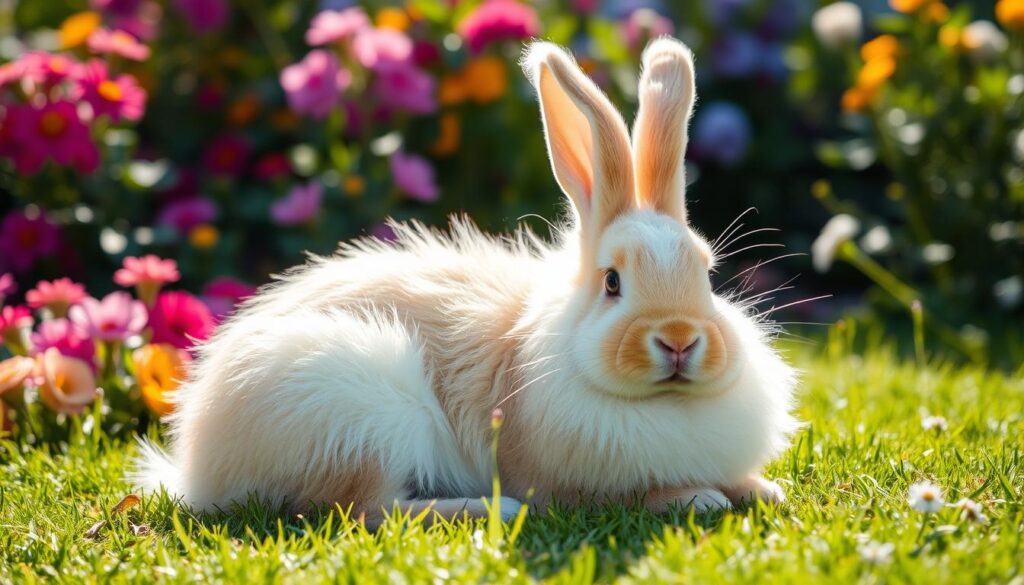
Angora rabbits are truly special pets. They capture the hearts of many with their unique angora rabbit temperament. These fluffy friends are not only beautiful but also have amazing personalities.
The angora rabbit temperament is known for several key traits:
- Gentle and calm demeanor
- High intelligence
- Strong social bonds with human companions
- Mild-mannered disposition
These rabbits are known for their calm and adaptable nature. They are great pets for families, individuals, and even those new to pet care. Angora rabbits love being around people and often form strong bonds with their owners.
“An Angora rabbit is not just a pet, but a fluffy companion with a heart of gold.” – Rabbit Enthusiast Magazine
Knowing about the angora rabbit temperament is key for a fulfilling relationship. They are quiet and enjoy gentle handling and social interaction. Each rabbit has its own personality, shaped by care and interaction.
These rabbits need a lot of attention, especially for their wool coat and social needs. They are perfect for those who are patient and can provide regular grooming and emotional support.
The Rich History of Angora Rabbits
The story of angora rabbits is truly captivating. It spans centuries and continents. These amazing animals come from Ankara, Turkey, where their wool was first loved.

Origins in Ancient Turkey
Angora rabbits come from Turkey’s mountains. There, their special wool was first noticed. Shepherds and textile workers loved it for its:
- Incredible softness
- Remarkable insulation properties
- Lightweight texture
Development of Modern Breeds
The journey of angora rabbit breeds was carefully planned. European traders brought them to new places. This led to the creation of different types.
| Breed | Origin Year | Key Characteristics |
|---|---|---|
| French Angora | 1857 | Dense, commercial wool production |
| English Angora | 1838 | Fluffy, show-quality appearance |
| German Angora | 1970s | High wool yield, industrial focus |
Historical Significance in Textile Industry
Angora rabbit wool became key in luxury textiles. Artisan craftsmen and industrial manufacturers alike valued its unique qualities. They made it into high-end clothes and accessories.
“The angora rabbit represents nature’s most exquisite wool producer” – Textile Historical Society
By the early 20th century, breeding angora rabbits was a big deal worldwide. Farmers and researchers worked hard to improve the wool and the rabbits themselves.
Different Types of Angora Rabbit Breeds
Angora rabbit breeds are a world of fluffy friends with special traits. They are loved for their soft wool and unique personalities. Rabbit fans have created many angora breeds, each with its own charm.

There are many angora rabbit breeds to choose from. This lets owners pick the best rabbit for them. Knowing the differences between breeds helps in making the right choice.
French Angora Characteristics
French Angora rabbits have thick, smooth wool and a strong body. They weigh 7-10 pounds and need regular grooming. Their wool is soft and long, making it great for textiles.
- Weight range: 7-10 pounds
- Coat type: Dense, smooth wool
- Temperament: Calm and friendly
English Angora Features
English Angora rabbits look like fluffy clouds. They are smaller, weighing 5-7 pounds. Their coat is very soft and needs a lot of care.
- Weight range: 5-7 pounds
- Coat characteristic: Extremely fluffy
- Grooming needs: High maintenance
German Angora Traits
German Angora rabbits are known for their wool. They are bigger and make more wool than others. They are bred for their wool and are calm.
- Primary focus: High wool production
- Size: Medium to large
- Wool quality: Consistent and dense
Giant Angora Specifications
Giant Angoras are the biggest angora rabbits. They can weigh up to 12 pounds and make a lot of wool. They are bred for commercial wool production.
- Maximum weight: Up to 12 pounds
- Wool production: Exceptional volume
- Breeding purpose: Commercial wool generation
“Each angora rabbit breed offers a unique combination of beauty, personality, and wool production capabilities.” – Rabbit Breeding Association
Physical Characteristics and Appearance
The angora rabbit is one of the most unique and eye-catching rabbit breeds. They have an amazing wool coat that makes them stand out. Their fur is incredibly soft and can grow up to several inches long.
Angora rabbits come in different sizes and colors. They have:
- Weight range: 5-12 pounds depending on the specific breed
- Distinctive round facial features
- Large, expressive eyes
- Ears that can be either upright or slightly folded
Their wool is truly special. Their coat is incredibly dense, soft, and can grow up to 3-5 inches in length. It feels like touching a cloud, making them look like walking clouds.
“An angora rabbit’s wool is so fine and soft that it feels like touching a cloud of pure silk.” – Rabbit Breeding Expert
Angora rabbits come in many colors. Some include:
| Color Category | Common Variations |
|---|---|
| Solid Colors | White, Black, Blue, Chocolate |
| Mixed Colors | Broken, Tri-color, Spotted |
| Rare Colors | Fawn, Lilac, Copper |
As angora rabbits grow, their wool changes. This makes them look different from when they were young. Their changing appearance makes them a fascinating and beautiful pet.
The Luxurious Angora Wool: A Premium Fiber
Angora rabbit wool is one of the finest natural fibers. It’s known for its softness and ability to keep warm. Fashion designers and textile lovers all over the world are drawn to it.
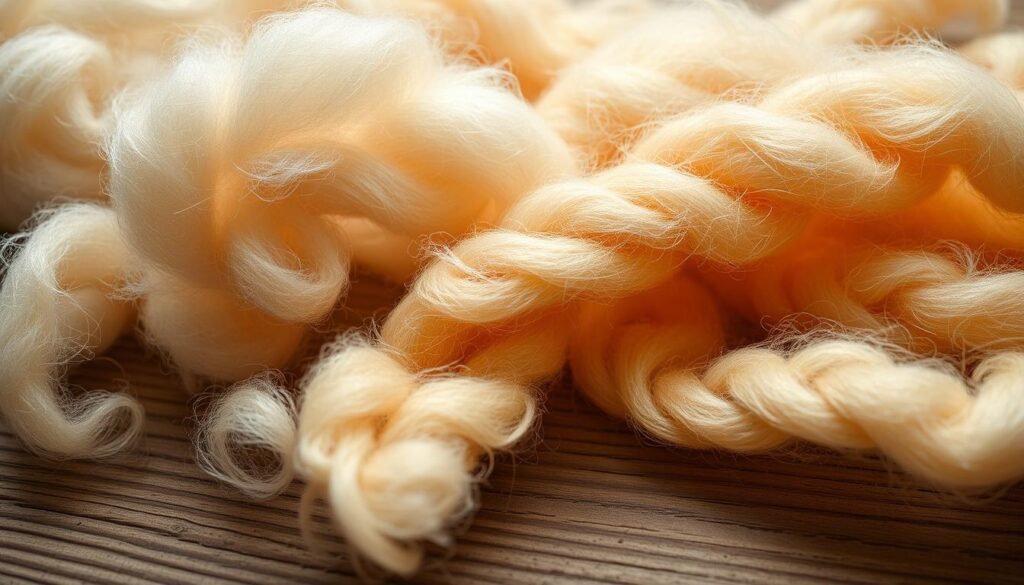
Unique Wool Quality and Properties
The angora rabbit wool has amazing qualities:
- It’s incredibly soft, like cashmere
- It keeps you warm without being heavy
- It’s light but insulates well
- It wicks away moisture well
Harvesting Methods for Premium Wool
Getting angora rabbit wool needs special care:
- It’s gently plucked during the molting season
- It’s sheared carefully with professional tools
- Wool collection is done with the rabbits’ comfort in mind
Commercial Value and Market Dynamics
| Wool Quality | Average Price per Pound | Global Demand |
|---|---|---|
| Premium Grade | $50-$100 | High-end fashion |
| Standard Grade | $25-$50 | Textile manufacturing |
| Craft Grade | $10-$25 | Handcraft markets |
“Angora rabbit wool represents the pinnacle of natural fiber luxury” – Textile Research Institute
The demand for angora rabbit wool is rising. Designers and manufacturers see its unmatched quality and unique features. This makes it a big deal in the global textile market.
Essential Care Requirements for Angora Rabbits
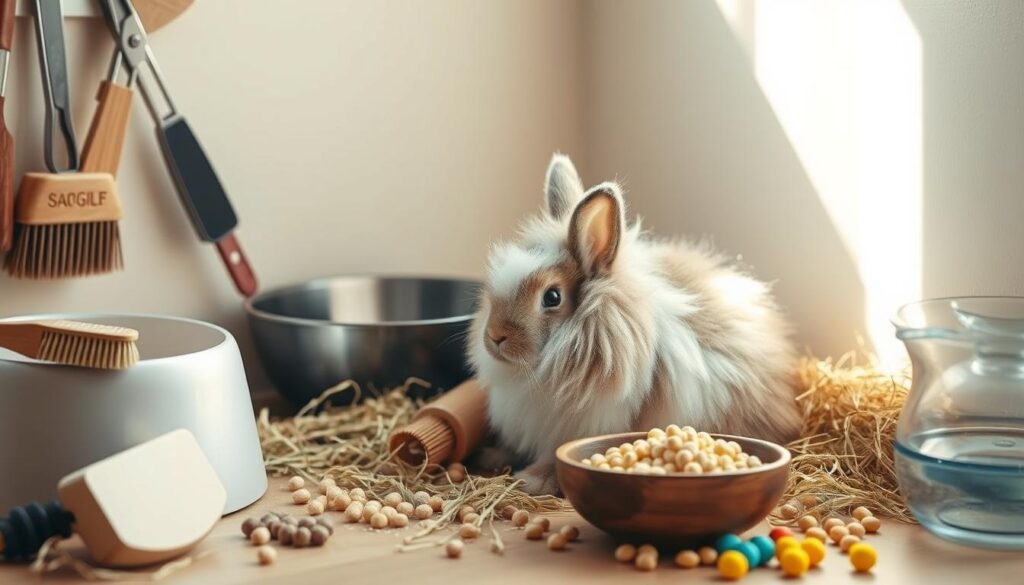
Caring for an angora rabbit needs a lot of time and special knowledge. These pets need a detailed care plan to stay healthy and happy. Good angora rabbit care means more than just owning a pet. It includes special grooming, diet, and keeping their environment right.
The most important parts of angora rabbit care are:
- Regular and extensive grooming
- Specialized dietary requirements
- Precise temperature control
- Consistent health monitoring
Grooming is the biggest challenge in caring for an angora rabbit. They need daily brushing to avoid mats and keep their fur looking great. Their fur grows fast, so they need careful grooming to stay comfy and healthy.
“An angora rabbit’s coat is its most precious asset and requires unwavering commitment.” – Rabbit Breeding Experts
What your angora rabbit eats is key to their health. They should eat high-quality hay, fresh veggies, and special rabbit food. Always make sure they have clean, fresh water. The right food helps avoid stomach problems and meets their special needs.
| Care Aspect | Frequency | Importance |
|---|---|---|
| Brushing | Daily | Critical |
| Nail Trimming | Monthly | Essential |
| Veterinary Check-ups | Bi-annually | Recommended |
Before getting an angora rabbit, know it’s a big commitment. They need patience, special knowledge, and regular care to do well at home.
Daily Grooming Techniques and Tools
Angora rabbit grooming is key to keeping their beautiful coats in top shape. Their woolly fur needs regular care to avoid matting and stay healthy.

Understanding the grooming needs of angora rabbits is important. Their soft, dense wool needs daily attention to prevent health problems and keep the coat looking great.
Essential Brushing Methods
- Use a slicker brush with soft, flexible bristles
- Brush in the direction of hair growth
- Brush gently to avoid skin irritation
- Spend 10-15 minutes daily on thorough grooming
Preventing Painful Mats
Preventing mats is vital in angora rabbit grooming. Mats can irritate the skin and lead to serious health issues if not treated.
| Grooming Tool | Purpose | Frequency |
|---|---|---|
| Metal Comb | Detangling fine wool | Daily |
| Slicker Brush | Removing loose fur | Every other day |
| Wide-toothed Comb | Checking for hidden mats | Weekly |
Seasonal Grooming Considerations
Seasonal changes affect angora rabbit grooming needs. During molting, groom more often and be gentle with their coat.
“Consistent grooming is the key to a healthy, happy Angora rabbit” – Professional Rabbit Breeder
Pro tip: Always use gentle, specialized grooming tools designed specifically for delicate rabbit wool to prevent skin damage and maintain coat integrity.
Nutrition and Dietary Needs
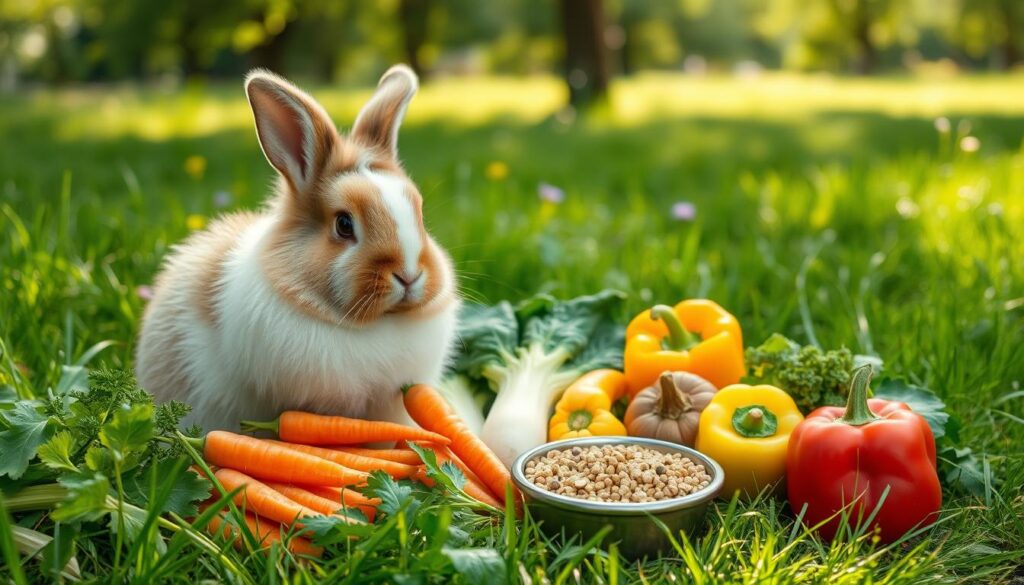
Keeping an angora rabbit’s diet right is key for their health and soft wool. They need a balanced diet to meet their special needs and grow their wool well.
Hay is the main part of an angora rabbit’s diet, making up 70-80% of what they eat. Timothy hay or orchard grass is best. It keeps their digestive system healthy and stops stomach problems.
- Fresh hay: Always available
- Commercial rabbit pellets: Specialized for wool breeds
- Limited fresh vegetables: Supplemental nutrition
- Clean water: Constantly accessible
Pellets made for angora rabbits should have lots of protein and fiber. Adult angoras need about 1/4 to 1/2 cup of pellets every day. This depends on their size and how active they are.
| Food Type | Daily Quantity | Nutritional Purpose |
|---|---|---|
| Hay | Unlimited | Digestive Health |
| Pellets | 1/4 – 1/2 cup | Protein & Fiber |
| Fresh Vegetables | 1-2 cups | Vitamins |
“A well-planned diet is the cornerstone of an angora rabbit’s health and wool quality.” – Rabbit Nutrition Experts
Safe veggies for them include carrots, leafy greens, and herbs. But, don’t give too much fruit because of the sugar. Start new foods slowly to avoid upset stomachs.
Good nutrition is not just for their health. It also helps their wool grow, making angora rabbits special.
Housing and Environment Setup
Creating the perfect home for your angora rabbit is key to their health and happiness. They need special living spaces that protect their wool and meet their needs.

Designing a cozy home involves thinking about both indoor and outdoor spaces. The right setup keeps your Angora rabbit safe, comfy, and happy.
Indoor Housing Essentials
Indoor homes for angora rabbits should be spacious and safe. Here are the must-haves:
- Minimum cage size of 4-6 square feet
- Solid-bottom wire cage with soft bedding
- Draft-free location away from direct sunlight
- Multiple levels for exploration
Outdoor Hutch Requirements
Outdoor homes need extra care for your Angora rabbit. Key things to consider are:
- Weatherproof shelter with solid roof
- Predator-resistant enclosure
- Raised platform to prevent ground moisture
- Removable windbreak panels
Temperature Control Strategies
Angora rabbits are sensitive to temperature changes. Keep the environment just right with these tips:
| Season | Temperature Range | Housing Adjustment |
|---|---|---|
| Summer | 60-70°F | Cool location, frozen water bottles |
| Winter | 50-60°F | Insulated hutch, extra bedding |
“A well-designed living space is the foundation of your Angora rabbit’s health and happiness.” – Rabbit Care Experts
Remember, good angora rabbit housing is more than just a place to live. It’s about creating a safe, comfy space that supports their physical and emotional health.
Health Considerations and Common Issues
Angora rabbits need special care because of their unique genetics and fluffy coat. It’s important to know about common health problems to keep them healthy and avoid serious issues.
Wool block is a big health problem for Angora rabbits. It happens when they eat too much fur while grooming. This can block their digestive tract and is very dangerous.
- Typical wool block symptoms include:
- Reduced appetite
- Decreased fecal output
- Lethargy
- Potential weight loss
To prevent wool block, keep your Angora rabbit’s fur clean and watch their digestion. Regular grooming and vet visits can help a lot.
“Prevention is always better than cure when managing Angora rabbit health issues.” – Veterinary Rabbit Specialists
Other important health issues include:
| Health Concern | Prevention Strategy | Warning Signs |
|---|---|---|
| Dental Problems | Regular tooth checks | Difficulty eating, drooling |
| Heat Stress | Cool environment, shade | Excessive panting, lethargy |
| Parasitic Infections | Routine veterinary screenings | Skin irritation, fur loss |
It’s crucial for owners to watch their Angora rabbit’s health closely. Take them to the vet at least twice a year. Catching health problems early can stop them from getting worse.
Breeding and Reproduction Guidelines
Breeding Angora rabbits needs careful planning and knowing their unique reproductive traits. Their lifespan is key in finding the best breeding times. These cute animals usually start breeding between 4-6 months old.
“Responsible breeding is the key to maintaining the health and quality of Angora rabbits.” – Rabbit Breeding Experts
Before starting a breeding program, consider these essential guidelines:
- Select healthy rabbits with excellent genetic backgrounds
- Ensure rabbits are at optimal breeding age (6-12 months)
- Conduct thorough health screenings
- Understand the typical angora rabbit lifespan of 7-12 years
Breeding considerations include:
- Reproductive Cycle: Female Angora rabbits (does) can produce multiple litters per year
- Gestation Period: Approximately 28-31 days
- Litter Size: Typically 4-6 kits per pregnancy
Successful Angora rabbit breeding demands commitment. Potential breeders must provide specialized care. This includes proper nutrition, regular vet visits, and detailed grooming. This care supports the rabbit’s health during their reproductive years.
Genetic diversity is crucial. Avoid inbreeding by carefully choosing breeding pairs and keeping detailed reproductive records. The aim is to keep the amazing traits of these wool-producing rabbits while ensuring their health.
Socializing Your Angora Rabbit
Building a strong bond with your Angora rabbit takes patience and understanding. These fluffy friends are both delightful and challenging to socialize. Success comes from creating a trusting relationship through gentle handling and positive experiences.
Bonding Techniques
Building trust with your Angora rabbit involves several key strategies:
- Start socialization early when the rabbit is young
- Use soft speaking tones during interactions
- Offer treats as positive reinforcement
- Spend consistent daily time together
Integration with Other Pets
Introducing your Angora rabbit to other pets needs careful management. Their sensitive nature means supervised interactions are crucial. Start with gradual, controlled meetings to ensure safety and comfort.
- Begin with short, supervised interactions
- Keep other pets calm and restrained
- Observe body language closely
- Separate pets if signs of stress appear
Training Basics
Angora rabbits are intelligent animals capable of learning basic commands and behaviors. Litter box training and simple verbal cues can be taught with positive reinforcement. Consistency and patience are key to successful training.
“Gentle guidance and regular practice transform your Angora rabbit into a well-socialized companion.” – Rabbit Care Experts
Understanding and respecting your Angora rabbit’s unique personality is crucial. It helps create a lasting, loving relationship that brings joy to both pet and owner.
Showing and Competition Standards
Competitive showing is the top goal for angora rabbit fans. Judges check these fluffy friends against strict rules. They look at many important traits.
When showing angora rabbits, there are a few main things to focus on:
- Wool Quality and Density
- Body Conformation
- Overall Health and Condition
- Breed-Specific Characteristics
Competitive showing is great for breeders and rabbits. It lets them show off the best of their breeding and the special traits of angora rabbits.
“A champion angora rabbit represents the pinnacle of breed excellence and genetic refinement.”
Judges use detailed scoring to judge angora rabbits. They look at things like:
- Wool length and texture
- Body symmetry
- Color consistency
- Temperament
| Breed Category | Judging Criteria | Maximum Points |
|---|---|---|
| French Angora | Wool Quality | 40 Points |
| English Angora | Body Conformation | 30 Points |
| Giant Angora | Size and Wool Density | 50 Points |
To do well in angora rabbit competitions, you need hard work, careful planning, and a good understanding of the breed standards. Winners spend a lot of time grooming, training, and getting their rabbits ready for the judges.
Conclusion
Raising an Angora rabbit is a special journey. It combines companionship with the chance to create unique textiles. These rabbits offer a unique mix of softness and wool production, unlike regular pets.
They need dedicated care and special grooming. Owners must also understand their unique needs. This requires a lot of time and effort.
Before getting an Angora rabbit, think about your lifestyle and resources. The time and money needed for their care are significant. But for those who love rare breeds and fiber arts, it’s a great chance to bond with a special animal.
Angora rabbits connect us to old textile traditions and sustainable fiber. They show us the deep bond between humans and animals. They are perfect for those who love animals, fiber, or unique pets.
Choosing an Angora rabbit means a lifetime of learning and joy. With the right love and care, they become beloved family members. They bring wonder and happiness every day.
FAQ
What are the main types of Angora rabbit breeds?
There are four main Angora rabbit breeds: French, English, German, and Giant Angora. Each has its own size, wool type, and personality. This gives owners a range of choices.
How much grooming do Angora rabbits require?
Angora rabbits need a lot of grooming every day. Their wool must be brushed 2-3 times a week to avoid tangles. This can take 30-60 minutes each time, making them a big responsibility for those who want an easy pet.
What is the lifespan of an Angora rabbit?
Angora rabbits can live 7-12 years with good care. Their life span depends on diet, living conditions, health care, and overall happiness. Regular vet visits and the right food can help them live longer.
What makes Angora rabbit wool special?
Angora wool is very soft, warm, and light. It’s warmer and softer than sheep’s wool. Its fine, fluffy fibers make it a luxury material for high-end clothes and accessories.
Are Angora rabbits good pets for families?
Angora rabbits can be friendly and social if they’re socialized well. They’re calm and like people. But, they need a lot of grooming and care, best for experienced owners or families with older kids.
What special dietary needs do Angora rabbits have?
Angora rabbits need a diet rich in fiber from hay, good pellets, and some veggies. Their food should help their health and wool growth. They also need clean water and careful food portions to stay healthy and avoid getting too fat.
How do I house an Angora rabbit?
Angora rabbits need a big, cool place to live. They do best indoors in a large cage or room. Their home should be safe, well-ventilated, have soft bedding, and enough room for them to move and play.
What are common health issues in Angora rabbits?
Angora rabbits can get wool block, dental problems, heat stress, and skin issues from their thick fur. Regular vet visits, good grooming, and a balanced diet can help prevent these problems.
Can Angora rabbits be kept with other pets?
Introducing Angora rabbits to other pets needs care and watching. They can live with calm dogs or cats if they’re socialized right. But, animals that hunt are a big risk. Always watch their interactions and make sure they have a safe place to themselves.
How often should I harvest Angora rabbit wool?
You can harvest wool every 3-4 months by plucking or shearing. The best method depends on the breed and the rabbit’s fur. Breeders often choose methods that are gentle on the rabbit.
